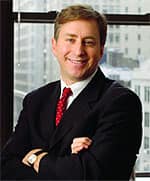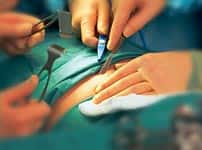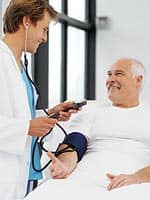Life Extension Magazine®
Q: I am a 55-year-old man who was just advised to undergo cardiac bypass surgery. It all began when I had pain in my chest and went to see my primary care physician. My doctor sent me to a cardiologist, who performed a coronary angiogram and told me I need bypass surgery in three arteries. This was devastating news, since I’ve always been healthy. I exercise and eat well, and have no history of heart disease in my family. I don’t want to undergo a major surgery like cardiac bypass unless it is absolutely necessary. What should I do? A: Here is the first thing you should know: in more than 15 years of practicing medicine, I have not recommended bypass surgery to a single patient of mine. So do not worry—you are not under the knife yet, and you might not need to go there. Coronary artery bypass grafting, known as bypass surgery, is one of the most common major surgeries in the United States. Each year, literally tens of thousands of patients undergo this procedure, which is designed to increase the flow of oxygen-rich blood to the heart muscle and thus prevent a heart attack. Although very common, this procedure can also be very debilitating. It may take patients up to three months to fully recover, and they will have to attend cardiac rehabilitation classes to learn new exercise and eating programs. Depression and memory loss are common side effects, as are large surgical scars. Worse yet, many people have to undergo multiple bypass surgeries or will need additional surgeries to address side effects such as infection of the surgical wound. Still, when a cardiologist says that you might die of a sudden heart attack and recommends cardiac bypass, most people are willing to deal with the unpleasant consequences of such a major operation. When I read about your case, it brought to mind another patient of mine, a healthy 72-year-old man I’ll refer to as Jon (not his real name), who gave me permission to write about his case. Like you, Jon led a healthy lifestyle and had no history of heart problems. However, in February 2003, he went to the doctor complaining of classic angina, or chest pain. Over the next few weeks, Jon was prescribed two heart medications: a beta-blocker and nitroglycerin. He also underwent various tests, including a thallium stress test, which he passed because he jogs regularly. Despite Jon’s favorable test results, the cardiologist, who practiced at a major hospital in New York City, asked Jon to return in one year for an echocardiogram. At Jon’s one-year follow-up visit, the cardiologist saw something that worried him, and he ordered an invasive coronary angiogram. This test involves threading a long, thin catheter up into the heart through an artery in the groin, and injecting a special dye that is visible under X-ray. When Jon woke up from this test, the first thing he saw was his “teary wife.” He soon learned that the cardiologist had identified 70% blockages in three of four coronary arteries. The cardiologist recommended an immediate emergency bypass operation. Jon’s condition was apparently so severe that bypass was the only option. Naturally, Jon was stunned and devastated. Fortunately, though, he insisted on a second opinion. His second doctor, who practiced at another major hospital in New York City, looked at the same test results and announced that Jon did not need bypass surgery after all. “Would you stake my life on that?” Jon asked his new doctor. The doctor said yes. Still not satisfied, Jon sought out yet another opinion. Before long, another cardiologist also said that Jon was not a candidate for bypass. Jon now had two cardiologists saying he was not a candidate for cardiac bypass, with a third cardiologist insisting that he needed emergency bypass right away. Stressed out and worried, Jon finally ended up in my office. He was confused and frightened, so I sent him to another cardiologist for a test known as a three-dimensional computed tomography (3-D CT) angiogram. This noninvasive test allows us to view the inside of the heart with great accuracy, without the use of needles or catheters. In some cases, it is as good as coronary angiogram, which it may one day replace.
But what about Jon’s original chest pain? It turned out that Jon was experiencing bronchospasm—a non-cardiac condition caused by spasm of the muscles lining the respiratory passages—caused by a drug side effect. In other words, his chest pain was not related to his heart at all! Thus, a healthy patient who had taken good care of himself almost underwent a major heart operation for no reason. Today, Jon remains a patient of mine. He takes various supplements to enhance his brain function, hormone therapy to replace hormones lost to aging, chelation therapy to remove toxins, and a supplement program that includes antioxidants and other heart-healthy substances such as fish oil and coenzyme Q10. Jon also takes inositol to help reduce anxiety. Although Jon’s case is scary, it illustrates several important points. The most important is that the need for bypass surgery arises as the result of a preventable condition, namely, coronary artery disease. If you take care of yourself, eat well, exercise, and take heart-healthy supplements, the chances are good that you may be able to avoid a bypass. Even in the case of relatively advanced heart disease, studies show that patients can stop and sometimes even reverse their disease by implementing dietary and lifestyle modifications. Second, it is a mistake to look only at the heart. We are only as a healthy as our sickest organs, so when a patient shows up with a complaint, it is important that the physician examine all the underlying possibilities. In Jon’s case, the first few doctors only considered his heart. That is akin to an auto mechanic fixing a flat tire by replacing the transmission. My approach to heart disease is based on four critical modalities: medical, nutritional, hormonal, and dietary. When a patient expresses concern about heart disease, these are some of the questions I ask: Are you stressed? This can contribute to high blood pressure, which can aggravate heart disease. (In Jon’s case, he was under a great deal of stress before this occurred.) Meditation and stress reduction have proven benefits in treating heart disease. Are your hormone levels balanced? As men age, they go through andropause, which is like menopause in women. During this time, testosterone and growth hormone levels decrease. Good overall health depends on healthy hormone levels. What is your diet like? It is impossible to understate how important diet is to a heart-healthy lifestyle. In general, you should be avoiding a high-fat, high-salt, and high-calorie diet. You should rely primarily on whole, organic foods, especially fruits, vegetables, and whole grains. Do you smoke? If so, stop. Smoking is clearly associated with serious heart problems. Have you sought a second opinion? All patients diagnosed with heart disease should get a second opinion. Always. Do you take any drugs? Most prescription drugs have side effects. It is very important that your physician know about all the drugs and over-the-counter supplements you take. In Jon’s case, a side effect from a prescription drug almost landed him on the operating table.
In addition, it is important that you are assessed using the best available diagnostic tests. The 3-D CT angiogram I recommended for Jon is a state-of-the-art test that allows physicians to measure a patient’s “calcium score.” This score measures how much calcified plaque has collected in the coronary arteries. Higher levels of coronary calcification are associated with an increased risk of future cardiovascular events such as heart attack, since a rupture of plaque can lead to heart attack. By assessing the calcium score and implementing aggressive steps to lower it, physicians can help their patients dramatically reduce their chances of suffering a heart attack. Heart disease is the nation’s leading killer of both men and women. Atherosclerosis, the process by which arteries become blocked with plaque, takes years to develop and often begins in childhood. This may give you and your physician plenty of time to identify and possibly reverse atherosclerosis. There are some situations in which a bypass surgery is necessary, such as serious blockage of the heart’s main coronary artery (the left main coronary). However, it is my belief that even these surgeries can be prevented through early and appropriate intervention using individualized exercise, nutrition, and supplement programs. Editor's note: While the three-dimensional computed tomography was clearly needed by Jon, readers should know that this diagnostic device is a potent X-ray that emits significant amounts of radiation. The invasive angiogram emits even more radiation. While a symptomatic individual (a person with suspected coronary artery disease) can benefit from these diagnostic procedures, Life Extension believes the radiation exposure is too great for three-dimensional computed tomography to be used as a screening test on otherwise healthy people. Dr. Braverman is the founder and director of PATH Medical in New York City. He is the author of seven books, including The Edge Effect (Sterling Publishing Co., 2004). For more information, visit www.EdgeEffect.org. |



